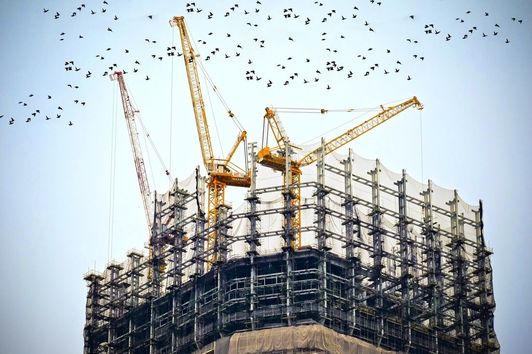|
Contributed by Russell Harrison In my last blog post we looked at the struggles a product rep has comparing a product that is specified that doesn’t match the drawings. Or, how we compare apples to oranges. In this post, we’re going to take it one level further and look at one small thing that happens at the subcontractor level during the bid phase. Before I go there, I’m going to sidetrack into the glazing side a bit, but we’ll bring it back around to the metal panel industry we spoke about in blog post #1, I promise! In a past life, I was a subcontractor in Oregon working in the commercial glazing realm. We would install anything glazing related in commercial buildings or high-end residences. That could be curtainwalls and storefronts, automatic door entrances, or even vinyl windows. The reason I bring this up is because it gave our team exposure to items from Divisions 5 (Metal), 7 (Thermal and Moisture Protection), or 8 (Openings). As our work was based around Division 8, this forced us to sometimes work with quite a few items outside of our realm of expertise and brought up a lot of questions internally. Anytime we had time to reach out to a rep and discuss the things we didn’t understand, we would do so. However, when our bid lead times were short, we’d have to make a lot of guesses. Guessing isn’t an abnormal occurrence in construction estimating. Unfortunately, it’s quite normal. Controlling the amount of guessing for subcontractors is an area where we can all help. Subcontractors, like most people involved in the commercial construction industry, have to clearly understand the work to bid a project accurately. As product reps, we try to work side by side with our subs to make sure they have all the information they need by the bid date so they can provide a thorough bid, but sometimes things happen outside of our control. A recent item outside of our control, and a very relevant example, would be our white-hot construction market in a booming economy.
During a construction boom, most estimating teams at the subcontractor level are working 60-70 hours a week in an attempt to keep up with the number of projects that are bidding. This doesn’t leave much, if any, time for other daily tasks. Estimators are typically very selective of what they will consider bidding during these times, will only work with general contractors (GC's) they like, will choose to bid jobs that are completely detailed and well specified, or will chose projects that fit into their available labor calendars.
3 Comments
Contributed by Eric D. Lussier I'm knee deep in a project right now that I'll call it what it really is: bailing the Owner out. Know what you get when you don't create bidding documents and rely solely on a low price? You get what you get. And if I say that phrase aloud in front of my 5 and 8-year-old, they add "and you don't pitch a fit".
Well, when one doesn't create an RFP, not to mention any sort of construction specification or drawing, how can one hold any level of expectation about their finished product? This Owner bought off a non-descriptive proposal and carried what matters most in the construction industry too much of the time: the lowest price. I don't have the time, the space, nor the want, to fully go down the road of the low-bid scenario. I will call it as I see it as a subcontractor: it's the short end of the stick. And yet it is still the "solution" for the most popular project delivery method in the construction industry today: design-bid-build. Let us Cliffs Notes design-bid-build within a tweet's 280-character limit: Owner has vision. Owner works with architect on design for vision. Architect develops schematics. Fine tunes. Vision formalized. Architect develops formal drawings & specifications for GC. Duration? Years? GC gets days to decipher vision. End result? Be cheapest. But that's simplifying things, you say. Sure, that may be. But in a nutshell, that's the process. One of the frustrating things about working with designers and developing specifications is becoming the basis of design, or an approved equal, only to be just breaking the sweat of the marathon race. Once you're named in a spec, you now must win the spec. And how do you ultimately win the spec? Match it and be the cheapest and ultimately, hope. Hope? Sure. Hope your price lands in the lap of the estimator in time. Hope they have time to read it. Hope they pick up what you're putting down. Hope they want to work with you. Hope you meet their qualifications to work together. Hope you can meet your estimate and make goal profit margin. Hope it all goes to plan. Hope you get paid in full in a timely fashion. Contributed by Jake Ortego Construction projects can be highly complex and unique endeavors. A successful project relies on each person/company performing their function as required. However, in many cases the exact roles and responsibilities of each entity is not mutually agreed upon, nor understood. Consider the following contrasts in expected functions.
Chances are that you have an opinion for each one of these examples. These examples focus on the architect, owner, and constructor. But that is only the tip of the iceberg. There are many more parties involved in the construction process and each major group can be made up of multiple professions with a wide range of functions, as well as approaches, to accomplish their scope. This includes estimators, schedulers, specifiers, owner’s reps, material reps, accountants, and legal counsel to name a few. As you read this, you are probably thinking that you already know who does what for the entire construction process. And it’s possible that your views are shared by people within your company or some of your local professional groups. But the standards can vary between industries, geography, project complexity, corporations, and even between two people sitting next to each other. To be clear, the primary definitions of many project roles can be agreed upon. Estimators estimate, schedulers schedule, engineers engineer, and so forth. But gray areas of responsibilities do exist, and it is these areas that may be the root of disagreements that can derail a project. So, what is the solution? A universal standard may seem to be the easiest answer. But imagine the complexities of having one standard that covers every possible industry, culture, and available resources for each project. Ideal…but probably not achievable. Contributed by Elias Saltz In my very first post on this site, the one titled, “Is Construction Broken?” I listed a few ways in which the profession of architecture is contributing to the ways in which construction is broken and needs to be fixed. I’m providing the link so readers can go back and refresh their memories on the whole discussion but for the rest of this post I will be addressing one observation, which reads in part: (Most but not all) Architects have very poor knowledge of how much construction costs, and use loose rules of thumb to try to determine whether or not their designs are within their clients’ budgets. They rarely know how the details they create affect the project cost, and the resulting necessary Value Engineering (VE) costs them time, money and prestige. As I’ve thought more about this, it occurs to me that this is one of the biggest problems facing the profession. The Owner’s money is not an unlimited fountain and most projects have some sort of budget, either a hard limit or a ‘this is where we’d like to be’ type of budget. Owners rely on architects to curate the expenditure of amounts of money that massively outweigh the architects’ own fees. They also rely on architects to develop designs that meet their facility needs.
When architects begin with the ‘design concept’ as the primary driver, or if they have a personal ‘favorite move’, the client’s budget is already at risk. Swoopy curves and other grand gestures may be considered the fun part for the architect and even for the building occupant, but complexity often carries a heavy premium. I learned recently of an office that designed an S-shaped, low-slung residence with structural insulated panels (SIP) instead of normal framing and sheathing for the roof structure. Each SIP would have needed to be custom made in a trapezoidal shape. Is there any wonder this project was significantly over budget? The resulting VE exercise cost the architects most of their interesting design as well as their (uncompensated) time, while it cost the client its seasonal construction window. It also generally cost goodwill all around. Contributed by Margaret Fisher Submitted Title 'Waaaaay too much information!' The Prequalification Form Gone Rogue
Ever since man stood up and decided he wanted something to cover the opening of his cave, the question exists, “Who can I rely on to do this work?” It was the dawn of the pre-construction qualification process. Back then, word of mouth or whoever was standing nearby got the job. Things stayed pretty much the same until just a few short decades ago. As the availability of more folks to do the job appeared on the scene, it became necessary to try to find some way to pick just one. But, what should the criteria be? So some GC’s, not all, started coming up with forms that ask fairly routine questions including your companies vital stats, such as your location, number of employees, last year’s sales, one or two recent projects that they can check out if they are so inclined, etc. This seems reasonable. In the end, the GC most often thought about who they worked with last and how it went. If it was a pretty good experience, they went with that gut feeling, the comfortable choice. “More” Isn’t Better; it’s Just More Today, we are in pre-qualification hell. It is not unusual to be asked to complete a 10-17 page form that takes a minimum of 10 hours to complete. More than one full work day for some. Smaller trades with less than 25 employees probably do not have one person who can afford to dedicate one full day completing these forms. If they are to be completed online, this adds another layer of complexity and additional time. In some cases, the forms cannot advance to the next page if you don’t have one answer at the ready and need to come back to it. Asking, Asking and More Asking . . . More and more subcontractors are now calling into question the very nature of some of these questions. The savvy subcontractor has brought prequalification questions to their attorney and accountant prior to completing forms. Generally, recommended by our attorney and our accountant, we do not answer some questions on manual or electronic. Basically, these would be the ones you wouldn’t ask in a hiring situation: Universally unacceptable to ask are questions regarding: Race, Religion, Marital Status, Gender, Sexual Orientation, Age, Military Involvement, Criminal conviction, Political Background, Ethnic Origin. HIPPA laws prohibit additional info sharing. Here are some examples gathered from various prequalification forms I have seen that are highly questionable:
That last one, well, if you think about it, how long would it take you to put that info together on just one project that you did 4-5 years ago? Now multiply that times perhaps 50 projects per year and multiply that times 5. As you can guess, it would take weeks to create that whole list and it would be about 125 pages long. How does this help anything? And I’m sure all those contacts they are asking for would not be pleased to find out we broadcast their phone numbers and email addresses on a form that could be viewed by who knows how many people. Again, how does ALL this prove skill or quality? That important information never comes up. |
AboutLet's Fix Construction is an avenue to offer creative solutions, separate myths from facts and erase misconceptions about the architecture, engineering and construction (AEC) industry. Check out Cherise's latest podcast
Get blog post notifications hereArchives
March 2022
Categories
All
|






 RSS Feed
RSS Feed
